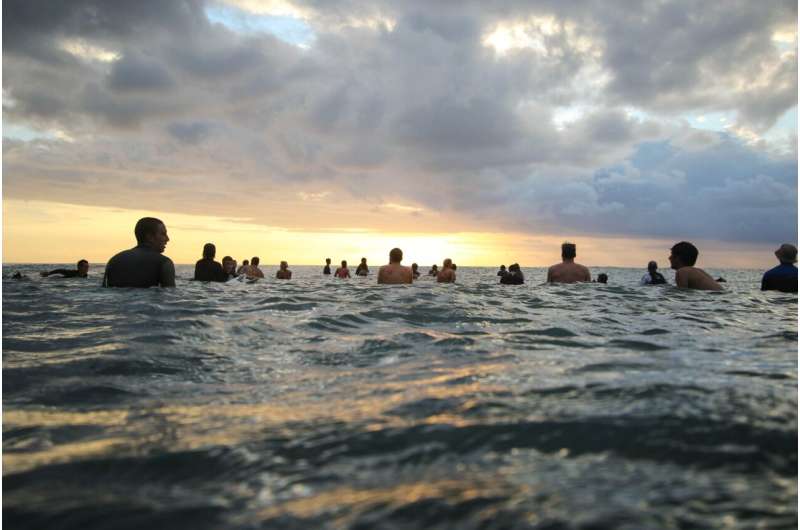
In many countries there has been an explosion in the number of people undertaking cold water immersion (CWI) for anecdotally claimed mental and physical benefits, from home-based ice baths and cold showers, to open water swims and dips.
The BBC One series Freeze The Fear, actively promoted CWI to improve the natural recovery process of the human body. However, world-leading researchers fear many individuals may take the plunge without taking the necessary precautions and considering the risks involved.
Last year, Her Majesty’s Coastguard (HMCG) in the U.K. reported a 52% increase in call-outs associated with swimming and dipping and, between 2018 and 2021, there was a 79% increase in open-water swimming deaths (34 to 61 deaths) in the U.K. In April, a woman died after reportedly immersing herself into a river as part of a cold water therapy session in Derbyshire.
For tropical animals like humans, viagra free sites computer news find immersion in cold water is stressful and carries a significant risk of respiratory, cardiovascular and, possibly, peripheral neurovascular injury. The most dangerous response associated with CWI is Cold Shock, which is caused by a rapid fall in skin temperature and includes gasping, hyperventilation, release of stress hormones, hypertension and arrhythmias.
A team from the Extreme Environments Laboratory at the University of Portsmouth has issued advice and guidance to anyone wishing to take up CWI as we approach the Autumn equinox (23 September) and water temperatures start to drop.
Professor Mike Tipton from the School of Sport, Health & Exercise Science at the University of Portsmouth, said, “Cold Water Immersion is not something that should be taken lightly, especially when Cold Shock and the loss of control of breathing can result in drowning.
“We encourage people to enjoy the water, but in a responsible way that maximizes the potential benefits and minimizes the risks.”
A new paper, published in British Journal of Sports Medicine, outlines what people can do to mitigate any risks associated with CWI. These include taking a medical assessment before entering cold water, nominating a safety observer and agreeing to an emergency signal, and entering the water slowly and gradually (see full list below).
Professor Tipton said, “Hopefully our paper will provide those undertaking or providing cold water immersion with a guide to doing this as safely as possible.
“This is a challenge that should not be undertaken casually; CWI is a major cause of accidental death internationally, but it is possible to reduce the risks of immersion in cold water, especially drowning and sudden cardiac death, to an extent. Sensible pre-screening and careful immersion in a controlled, supervised and incremental way help in this regard.”
A study led by the University of Portsmouth, in partnership with the Sussex Partnership NHS Foundation Trust, is currently examining the impact of an outdoor swimming intervention for people experiencing symptoms of depression.
Dr. Heather Massey, who is co-leading the trial, said, “It is very important people think before you swim. Outdoor swimming is an extreme sport. Our participants have been medically screened before the swimming courses start to check they are physically well enough to take part.
“The swim courses are also being run by experienced, qualified open water swim coaches who have a good knowledge of their local waters and the potential hazards, as well as understanding the impact that cold water can have on us.”
Advice for CWI participants
- When undertaking any significant physical challenge for the first time, a medical assessment is recommended
- Ideally, swimmers should use lifeguarded areas, and participate with experienced outdoor swimmers, coaches or lifeguards
- Nominate a (trained) safety observer and agree on an emergency signal when a swimmer needs help (the international emergency signal is to wave one hand)
- For visibility, swimmers should wear a bright swimming hat and use a tow float (with name and emergency number on it)
- Start CWI mid-summer and wear a wetsuit, at least initially, to reduce the rate of cooling and increase buoyancy
- Cold water should be entered gradually; do not jump or dive in
- Cold shock peaks in water between 10 and 15°C in the first 30 seconds, so allow this response to subside before swimming or immersing the face, and avoid prolonged breath holds
- Start with short immersions within your depth, only extend the swim duration if your stroke remains well coordinated with no muscle stiffness
- Make immersions shorter (less than 10 minutes) in colder water to avoid incapacitation due to muscle cooling; this can occur with little warning
- If in difficulty in the water, float on your back moving your arms and legs as little as you need to stay at the surface of the water
- Carry a “pea-less” whistle on the wrist, tow float or wetsuit leash so you can attract attention
- On exit, dry and dress quickly in warm clothing with a windproof outer layer
- Continued cooling occurs for approximately 30 minutes after exiting the water; avoid driving during this period
Source: Read Full Article
